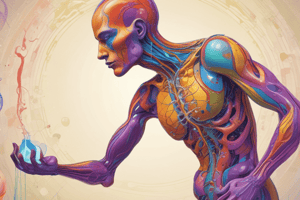Podcast
Questions and Answers
What condition is characterized by impaired oxygen transfer and can lead to hypoxemia?
What condition is characterized by impaired oxygen transfer and can lead to hypoxemia?
- Pulmonary embolism
- Emphysema (correct)
- Chronic bronchitis
- Cystic fibrosis
Which effect is caused by both impaired ventilation and diffusion?
Which effect is caused by both impaired ventilation and diffusion?
- Increased oxygen saturation
- Decreased respiratory rate
- Lower heart rate
- Hypercapnia (correct)
What physiological process is primarily affected by impaired diffusion?
What physiological process is primarily affected by impaired diffusion?
- Cardiac cycle
- Neural control of heart rate
- Gas exchange in alveoli (correct)
- Blood pressure regulation
Which of the following is NOT a clinical model associated with altered perfusion?
Which of the following is NOT a clinical model associated with altered perfusion?
What occurs when there is a mismatch between ventilation and perfusion?
What occurs when there is a mismatch between ventilation and perfusion?
What is one potential consequence of impaired cardiac output?
What is one potential consequence of impaired cardiac output?
Which diagnostic measure can be used for assessing impaired diffusion?
Which diagnostic measure can be used for assessing impaired diffusion?
What is a common manifestation of altered perfusion?
What is a common manifestation of altered perfusion?
In myocardial infarction, which aspect of the heart function is primarily compromised?
In myocardial infarction, which aspect of the heart function is primarily compromised?
What is the consequence of hyperkalemia in the body?
What is the consequence of hyperkalemia in the body?
Which of the following does NOT contribute to fluid imbalance?
Which of the following does NOT contribute to fluid imbalance?
What can occur if the physiologic pH of the body deviates significantly from the normal range?
What can occur if the physiologic pH of the body deviates significantly from the normal range?
Which electrolyte is primarily regulated by the kidneys and can lead to hyperkalemia if not properly managed?
Which electrolyte is primarily regulated by the kidneys and can lead to hyperkalemia if not properly managed?
Which fluid type is considered hypotonic?
Which fluid type is considered hypotonic?
What is one of the primary functions of bicarbonate in the body's buffering system?
What is one of the primary functions of bicarbonate in the body's buffering system?
Which condition commonly leads to dehydration and possibly results in hypovolemia?
Which condition commonly leads to dehydration and possibly results in hypovolemia?
Which of the following statements about acid-base balance is true?
Which of the following statements about acid-base balance is true?
Which electrolyte is most likely to become imbalanced due to renal failure?
Which electrolyte is most likely to become imbalanced due to renal failure?
What is a potential cause of hypocalcemia?
What is a potential cause of hypocalcemia?
Flashcards
Electrolyte Functions
Electrolyte Functions
Electrolytes like sodium (Na+), potassium (K+), calcium (Ca2+), magnesium (Mg2+), chloride (Cl-), bicarbonate (HCO3-) are essential for various bodily functions like nerve impulses, muscle contractions, and maintaining fluid balance.
Sodium (Na+) Imbalance
Sodium (Na+) Imbalance
Sodium (Na+) is the major cation in extracellular fluid. Hypokalemia (low sodium) causes low blood pressure, weakness, and confusion. Hypernatremia (high sodium) causes thirst, headache, and confusion.
Potassium (K+) Imbalance
Potassium (K+) Imbalance
Potassium (K+) is the major cation inside cells. Hypokalemia (low potassium) causes muscle weakness, fatigue, and irregular heartbeat. Hyperkalemia (high potassium) causes muscle weakness, paralysis, and irregular heartbeat.
Calcium (Ca2+) Imbalance
Calcium (Ca2+) Imbalance
Signup and view all the flashcards
Fluid Compartments
Fluid Compartments
Signup and view all the flashcards
Fluid Tonicity
Fluid Tonicity
Signup and view all the flashcards
Hypovolemia
Hypovolemia
Signup and view all the flashcards
Physiologic pH
Physiologic pH
Signup and view all the flashcards
Buffer Systems
Buffer Systems
Signup and view all the flashcards
Ventilation
Ventilation
Signup and view all the flashcards
Gas Diffusion
Gas Diffusion
Signup and view all the flashcards
Ventilation/Perfusion Mismatch
Ventilation/Perfusion Mismatch
Signup and view all the flashcards
Cardiac Output
Cardiac Output
Signup and view all the flashcards
Homeostasis
Homeostasis
Signup and view all the flashcards
Hypertension
Hypertension
Signup and view all the flashcards
Shock
Shock
Signup and view all the flashcards
Heart Failure
Heart Failure
Signup and view all the flashcards
Myocardial Infarction (Heart Attack)
Myocardial Infarction (Heart Attack)
Signup and view all the flashcards
Stroke
Stroke
Signup and view all the flashcards
Study Notes
Chapter 8: Altered Fluid and Electrolyte Balance
- Electrolytes have specific functions in the body
- Imbalances can occur due to various factors like vomiting, diarrhea, and diuretic use
- Electrolyte imbalances can lead to a variety of conditions
- Fluid movement in and out of cells and tissues is crucial
- Body regulates fluid intake and excretion
- Types of fluids include isotonic, hypertonic, and hypotonic
- Fluid imbalances can manifest as hypovolemia, hemorrhage, dehydration, and hypervolemia (edema)
Chapter 9: Altered Acid-Base Balance
- Maintaining a specific pH is essential for cellular function
- Alterations in pH impact cell and tissue function, impacting bodily functions
- Body uses buffer systems to regulate pH
- Models of acid-base imbalance include metabolic acidosis
Chapter 15: Altered Ventilation and Diffusion
- Ventilation and diffusion are critical for gas exchange
- Ventilation involves breathing in and out
- Diffusion involves gas movement across membranes
- Impaired ventilation and diffusion lead to conditions like hypoxemia, hypoxia, and hypercapnia
- Treating these issues involves correcting underlying problems
Chapter 16: Altered Perfusion
- Perfusion is the delivery of blood to tissues
- A pathway starts from ventilation and leads to perfusion
- The circulatory system is involved in this process
- Examples include pulmonary and systemic pathways
- Important conditions associated with altered perfusion include conditions like COPD, asthma, cystic fibrosis, hypertension, stroke, myocardial infarction, and heart failure.
Studying That Suits You
Use AI to generate personalized quizzes and flashcards to suit your learning preferences.




